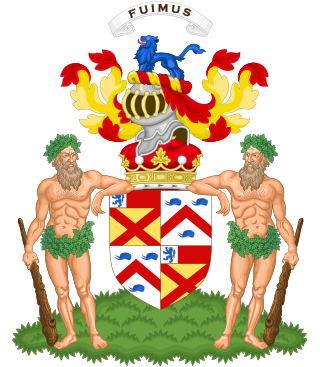
Earl of Longford is a title that has been created twice in the Peerage of Ireland.

Duke of Atholl, named after Atholl in Scotland, is a title in the Peerage of Scotland held by the head of Clan Murray. It was created by Queen Anne in 1703 for John Murray, 2nd Marquess of Atholl, with a special remainder to the heir male of his father, the 1st Marquess.

Marquess of Londonderry, of the County of Londonderry, is a title in the Peerage of Ireland.

Marquess Conyngham, of the County of Donegal, is a title in the Peerage of Ireland. It was created in 1816 for Henry Conyngham, 1st Earl Conyngham. He was the great-nephew of another Henry Conyngham, 1st Earl Conyngham, a member of a family of Scottish descent which had settled during the Plantation of Ulster in County Donegal in Ireland in the early 17th century. The 'founder' of the dynasty in Ireland was The Very Rev. Dr. Alexander Cunningham, Dean of Raphoe. The earlier Henry was a member of both the Irish House of Commons and the British House of Commons and served as Vice-Admiral of Ulster and as Governor of the counties of Donegal and Londonderry. In 1753 he was raised to the Peerage of Ireland as Baron Conyngham, of Mount Charles in the County of Donegal, and in 1756 he was created Viscount Conyngham, in Ireland, also in the Peerage of Ireland. In 1781 he was made Baron Conyngham, of Mount Charles in the County of Donegal, with remainder to his nephew Francis Burton, and Earl Conyngham, of Mount Charles in the County of Donegal, which like the creations of 1753 and 1756 was created with normal remainder to the heirs male of his body. The latter titles were also in the Peerage of Ireland. Lord Conyngham was childless and on his death in 1781 the barony of 1753, the viscountcy and earldom became extinct while he was succeeded in the barony of 1781 according to the special remainder by his aforementioned nephew Francis. He was the eldest son of Mary, sister of the first Earl Conyngham, by her husband Francis Burton. The new 2nd Baron Conyngham, who had earlier represented Killybegs and County Clare in the Irish House of Commons, assumed by Royal licence the surname and arms of Conyngham on succeeding to the titles.

Marquess of Ailesbury, in the County of Buckingham, is a title in the Peerage of the United Kingdom. It was created on 17 July 1821 for Charles Brudenell-Bruce, 2nd Earl of Ailesbury.

Earl of Cardigan is a title in the Peerage of England that was created by Charles II in 1661 for Thomas Brudenell, 1st Baron Brudenell, and the title has been held since 1868 by the Marquesses of Ailesbury. Since that time, it has been used as a courtesy title by the heir apparent to that Marquessate, currently Thomas Brudenell-Bruce, Earl of Cardigan, only son of the 9th Marquess.
Baron Ravensworth, of Ravensworth Castle in the County Palatine of Durham and of Eslington Park in the County of Northumberland, is a title in the Peerage of the United Kingdom.

The House of Seymour, Semel or St. Maur, is the name of an old English family in which several titles of nobility have from time to time been created, and of which the Duke of Somerset is the head.

Ernest Augustus Charles Brudenell-Bruce, 3rd Marquess of Ailesbury,, styled Lord Ernest Brudenell-Bruce from 1821 until 1878, was a British courtier and politician. He served for many years as Vice-Chamberlain of the Household.

Thomas Henry Liddell, 1st Baron Ravensworth, known as Sir Thomas Liddell, 6th Baronet, from 1791 to 1821, was a British peer and Tory politician.

Charles Brudenell-Bruce, 1st Marquess of Ailesbury,, styled The Honourable Charles Brudenell-Bruce from birth until 1783, Lord Bruce until 1814 and The Earl of Ailesbury until 1821, was a British peer and politician.

George William Thomas Brudenell-Bruce, 4th Marquess of Ailesbury, styled Viscount Savernake from 1878 to 1886, was the son of George John Brudenell-Bruce and Lady Evelyn Mary Craven, and succeeded his grandfather as 4th Marquess on the latter's death on 18 October 1886. On his death in 1894 he was succeeded in the marquessate, and his other titles, by his uncle. According to family records, he went by the name William and was known informally as Willie.

Thomas Brudenell-Bruce, 1st Earl of Ailesbury, KT, styled The Honourable Thomas Brudenell until 1747 and known as The Lord Bruce between 1747 and 1776, was a British courtier.
Thomas Pakenham, 2nd Earl of Longford,, known as The Lord Longford between 1792 and 1794, was an Anglo-Irish peer.

Charles Bruce, 3rd Earl of Ailesburyand 4th Earl of Elgin, of Ampthill, Bedfordshire and Savernake Park, Wiltshire, styled Viscount Bruce of Ampthill from 1685 to 1741, was a British landowner and Tory politician who sat in the English and British House of Commons from 1705 until 1711 when he was raised to the peerage as one of Harley's Dozen and sat in the House of Lords.
The Royal Households of the United Kingdom consists of royal officials and the supporting staff of the British Royal Family, as well as the Royal Household which supports the Sovereign. Each member of the Royal Family who undertakes public duties has his own separate Household.
The 1902 Coronation Honours were announced on 26 June 1902, the date originally set for the coronation of King Edward VII. The coronation was postponed because the King had been taken ill two days before, but he ordered that the honours list should be published on that day anyway.

The 1874 Dissolution Honours List was issued in February 1874 prior to the general election at the advice of the outgoing Prime Minister, William Gladstone.
The 1885 Dissolution Honours List was issued in June 1885 prior to the general election of that year.
The 1892 Dissolution Honours List was issued in August 1892 following the general election of that year.













